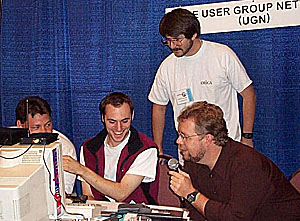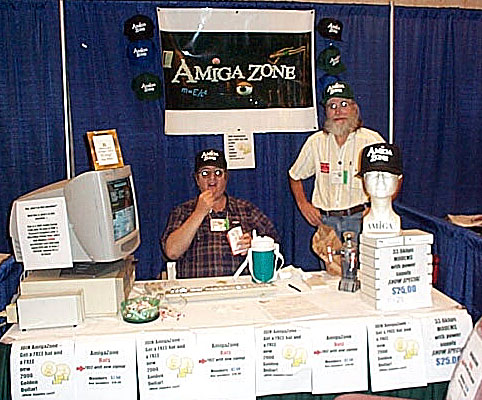AmiWest From the Developer's Eye
AmiWest 2000 was gearing up to celebrate its third year as developers and
dealers began to arrive on the Thursday and Friday before the
Sacramento, California show. The
usual last minute crisis here and there had everyone rushing around,
calling their offices and shipping companies, but most everything settled
down in time for the show on Saturday. The biggest disappointment was that
the new d'Amiga Developer Workstation, which Software Hut had arranged to
have at the show, was lost by UPS and didn't make it to the show in time
for everyone to see it in action.
Friday night Kermit Woodall (your reporter) hosted an Amiga Developer
meeting on the exhibit floor and stage to discuss various issues
concerning developers. Compliments were offered to Amiga for the release
of the SDK and the d'Amiga Workstation in such a short timeline. It was
observed that these, following on the release of AmigaOS 3.5 for the
Classic Amiga, had done much for resellers and distributors in the Amiga
market.
The passing of Amazing Computing for the Amiga Computer (aka: Amazing) was
sadly noted. This magazine had been a mainstay of the U.S. Amiga scene
since the beginning and its loss is keenly felt by developers who now lack
an advertising source that reached as wide an audience as Amazing did. G&G
Publishing recommended everyone to their new Amiga publication, called The
NEW AMIGANS. 
The Amiga
User Group Network broadcasted an interview with Bill McEwen on the
Internet.
It was also suggested that the User
Group Network
(UGN) should prompt their member user groups to promote the advertising
pace in their newsletters more aggressively to developers. Perhaps with
all of these resources, developers can once again reach their target
audience - at least to some degree. There is also the promise of the UK's
Amiga Active coming to the U.S. as well.
The meeting ended after some roundtable discussion and hopes were voiced
that Amiga might be able to offer more financial benefits and direction
for developers directly or some program that might benefit Amiga
developers the way current programs are benefiting resellers.
Saturday the show opened with a presentation of the BoXeR Amiga
system. Previously announced by Access Innovations and Blittersoft, the
rights to this system were bought last year by California-based Anti
Gravity, who plans to launch a new line of Classic Amiga architecture
systems using far more advanced hardware designs. Mick Tinker, the
original designer, has gone on to work for ARM in the U.K., but has
continued to work on the design. In a surprise announcement, it was
revealed that Anti Gravity had hired former Amiga/Gateway employee Joe
Torre some time ago to oversee and complete the hardware design of the
BoXeR for them. Joe Torre is highly regarded in the Amiga developer
community and his involvement in this project was welcome news for
all. Anti Gravity's Dan Lutz and Scott Sutherland had many meetings
throughout the show with Amiga developers and the promise of a
much-improved and faster Amiga platform, for people using the current
architecture, seems much closer finally.
Saturday night Bill McEwen spoke at the show's banquet. He quickly
demonstrated Amiga/Elate in a hosted environment under Linux and Windows
and showed how the same binary can be shared and run by both
systems. While McEwen did not specifically make note of the following,
many in the audience observed how much faster and smoother the demo ran
under Linux as opposed to Windows on what appeared to be otherwise
identical hardware platforms.
Bill showed videos from his recent appearances on CNN:fn and ZDTV to an
appreciative audience who for the most part had not had the chance to see
these in anything but a small window streamed over the Internet.
He mentioned that the SDK is selling better than forecasted. Amiga have
been in contact with numerous major consumer electronics and software
companies, including (and I quote) "every major gaming company out
there". Many of these already possess the SDK. Interest from major
companies particularly picked up after Bill's two recent TV
appearances. Specifically he noted that Amiga was able to directly track
the sales of SDKs sold through Amazon.com to several major companies.
The AmigaOne, the next generation Amiga reference platform, is currently
targeted at December of this year for release. Based on Amiga's own
customized motherboard design, and using standard parts, the AmigaOne will
be the first product designed by the in-house hardware division which is
led by Dean Brown. Dean, formerly of DKB (an Amiga hardware developer), is
creating custom hardware designs for various devices that will be then
offered to 3rd parties to manufacture and use as reference designs.
A version of the SDK for Windows will be made available next month and
will be sporting a brighter and more upbeat box design. Some have
criticized the current SDK box as being a bit dark apparently. Amiga's new
SDK box design is quite nice and shows a Boing in the process of being
constructed.
The SDK license issues have been of great concern and the focus of a
number of informal developer meetings online and off. Bill clarified all
of this when he revealed that the license included in the SDK was
incorrect and was not intended for release with the SDK. The final
information (as of the show) was that no software developers would be
forced to pay royalties. The program is a voluntary certification process
that they can sign up for. The program puts the software through a
certification process, which will result in their products receiving an
official Amiga "badge" and the opportunity to have their product co-op
marketed by Amiga in various campaigns. This will cost 5% or just $1.50
per sold item.
During a discussion of the d'Amiga Workstation, it was also revealed that
the "$1000" developer support package that is included with the d'Amiga
would include having a specific developer support person assigned to the
developer, a ticket to an upcoming Amiga Developer Conferences and
more. Developer reaction to this information was very positive.

Harv Laser (left) of Amiga Zone, an
Amiga-specific online service
Some other tidbits: Red Hat will start selling the SDK next week. Sun has
started using Amiga software to demo Java stuff. There are going to be
public beta releases of the AmigaDE prior to release. Paul Nolan (author
of Photogenics) is now doing contract work for Amiga in the User Interface
division. Amiga will start offering low-cost promotional merchandise to
user groups. An ARM produced (and designed by Mick Tinker) touch screen
unit was demonstrated showing Amiga/Elate running in native mode. The
prototype was designed for vertical markets and is completely solid-state
constructed.
For current Amiga developers one of the most welcome bits of news was that
backwards compatibility to the Classic Amiga from the new AmigaDE will be
dealt with by an Emulation Layer. They've also ported UAE to the new
AmigaDE, but the Emulation Layer is to provide a far more transparent
method (compared to Mac OS X's handling of legacy applications) for
current Amiga applications to run directly on the new AmigaDE.
Sunday the show closed on a note of optimism. Sales had been brisk all
weekend and some developers, such as Nova Design, even sold out of the
entire product line they brought with them! Developers are happy with the
positive steps Amiga is making and hope this trend will continue. After a
long time of tightening their belts, Developers and users alike are
finally starting to look to the future AmigaDE with hope of a bright
future.

|